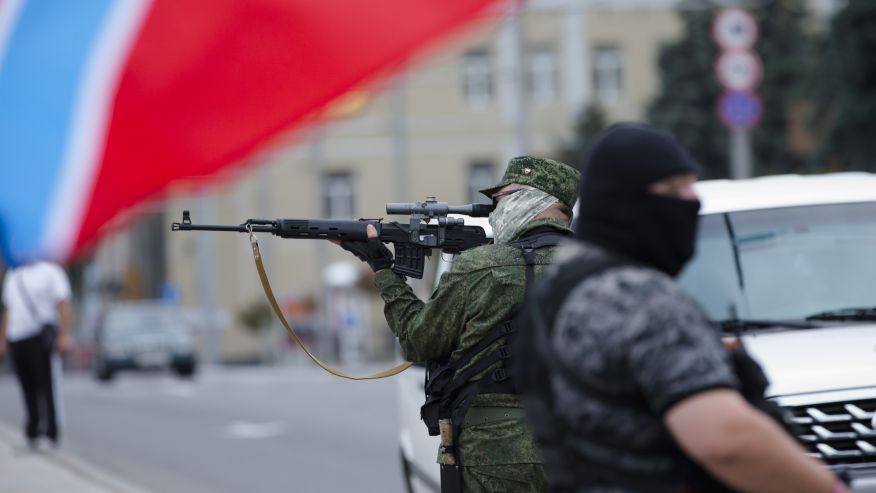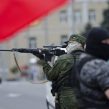
Putin’s War for Novorossiya
Publication: Eurasia Daily Monitor Volume: 11 Issue: 152
By:

After recent successes by Russia-backed rebel forces in southeastern Ukraine, increased reports of Russian regular troops involved in the conflict, and belligerent statements by the Russian leadership, speculation mounts in Moscow as to the nature of the Kremlin’s “war aims.” Some clues as to Moscow’s evolving tactical and strategic aims in Ukraine have emerged from presidential statements, Russian military activity in Ukraine, the continued deployment of combined-arms forces near the border, and the assembling of peacekeeping forces that appear ready to commence an operation. On August 31, President Vladimir Putin called for substantive talks on possible “statehood” for southeastern Ukraine, and added that the conflict remains “unpredictable.” Far from implying nearing an endgame in the crisis, Putin leaves open an uncertain end state of the present conflict (Channel One TV, August 31).
The recent escalation of the conflict in southeastern Ukraine was marked by the use of a humanitarian aid convoy illegally entering the country, evidence gathered by the North Atlantic Treaty Organization (NATO) of Russian troops and military hardware actively involved in clear violations of Ukraine’s sovereignty, as well as Russian support for separatists to open a second front in Mariupol, which resulted in the European Union issuing an ultimatum requiring Moscow to reverse its course in the crisis or face fresh sanctions. “Plausible deniability” of such direct involvement was dealt a blow with the capture of a company of soldiers on Ukrainian territory from the elite Airborne Forces (VDV); Moscow’s claims that these troops had lost their way presaged a prisoner exchange on August 30. Although Sweden’s Foreign Minister Carl Bildt characterized Russia’s actions in the latest developments as marking its “second invasion” within one year, Moscow commentators have highlight the reportedly low number of Russian forces allegedly involved. NATO’s official estimate was that 1,000 Russian troops were engaging in operations, while some Western media outlets were told off-the-record by Western government agencies that the actual figure may be around 5,000. These relatively low figures for an “invasion force” caused puzzlement among Russian commentators (Ekho Moskvy, August 30).
Indeed, these surprisingly low numbers for Russian troops deployed within the conflict zone raise questions as to their purpose and the long-term Kremlin strategy to resolve the crisis. Given the estimated 18,000 or more combat-ready combined-arms troops close to the Ukrainian border, and the use of the humanitarian aid convoy as a possible Trojan horse, the numbers thus far reported do not support a full invasion. By September 1, amid fresh calls from Foreign Minister Sergei Lavrov for an unconditional ceasefire and talks between the authorities and the Ukrainian separatists, the Ukrainian Armed Forces were apparently engaged in battle with a Russian tank battalion close to Luhansk airport. Earlier, the Moscow-based military publication Voyennoye Obezreniye speculated on the possible future targets for operations in southeastern Ukraine in what it saw as a “the probable future war for Novorossiya” (Voyennoye Obezreniye, accessed August 31).
The first target, according to this analysis would be Mariupol; to dislodge Ukrainian forces in order to open a fresh re-supply route from Russia. The second, Volnovakha, would sever the link to the Azov group of forces. Others mentioned are: Donetsk (especially the airport), Debaltsevo, the Lisichansk-Rubezhnoye-Severodonetsk area, which Ukrainian forces have allegedly fortified, and Luhansk and the surrounding areas to alleviate pressure on separatist forces. The article concluded that over a two-month time frame, the aim would be to allow separatists to “hold out” and thus render Kyiv less of a problem for Moscow and Novorossiya (Voyennoye Obezreniye, accessed August 31).
Given the article’s stress on Novorossiya—the term used in Tsarist Russia to refer to southeast Ukraine—it is worth recalling Putin’s use of the word in his “annexation speech” on Crimea and, more pointedly, his use of it on August 29 to praise the separatists. The deployment of small numbers of Russian troops in the conflict zone as an additional layer of support for the separatists while avoiding a larger-scale incursion, seems predicated on Putin’s core tactical aim: to smash the Ukrainian anti-terrorist operation (ATO). If this is achieved, it will also facilitate the insertion of Russian peacekeepers into the area and promote a de facto state within a state.
Putin maintains pressure on Kyiv using a broad mix of diplomatic, economic, political, informational and military mechanisms. In addition to supporting the rebels with materiel, deploying some Russian Ground Forces, and by maintaining high-readiness forces close to the border, he has maximized the fear caused by the aid convoy and the use of small numbers of Russian troops; these appear to constitute psychological operations (PSYOP) designed to achieve ends with minimal forces. In the background, the threat to deploy peacekeepers remains real and viable. According to senior officers in the VDV, the Russian military has also formed a credible and potentially potent peacekeeping force (Nezavisimoye Voyennoye Obozreniye, August 29).
The joint military exercises Nerushimoye Bratstvo-2014 (Kyrgyzstan) and Vzaimodeystviye-2014 (Kazakhstan) tested the combat and peacekeeping skills of these units under a Collective Security Treaty Organization (CSTO) umbrella. The CSTO exercise in Kazakhstan modeled the scenario on an intervention in a neighboring country, which seemed strikingly similar to events in Ukraine (odkb-csto.org, August 19). In fact, the CSTO cannot legally deploy out of area without the approval of the United Nations. But honing these skills, according to the VDV’s commander, Colonel-General Vladimir Shamanov, means the VDV should expect to deploy beyond the country’s borders. VDV Deputy Commander for Peacekeeping Operations and the CSTO Collective Rapid Reaction Forces, Major-General Aleksandr Vyaznikov, said that the formation of peacekeeping forces with over 5,000 personnel has been completed in the VDV. “As of today, besides the 31st Separate Air Assault Brigade, five more peacekeeping battalions—one battalion in each formation—have been formed in the Airborne Troops.” In addition, the Ground Forces’ 15th Peacekeeping Brigade and the peacekeeping battalion in each naval infantry brigade, provides a large range of such options at the Kremlin’s disposal (Nezavisimoye Voyennoye Obozreniye, August 25).
Putin’s use of the term “Novorossiya” thus comes at a time of increased uncertainty and tension in the crisis. His authorization of both the aid convoy as well as a limited troop deployment in an apparent PSYOP to undermine the ATO is working to date to push back the Ukrainian government’s forces. But the same motif will likely lose its impact if used repeatedly, and thus raise the stakes still further, inadvertently risking inter-state war. Beyond these tactics, the wider strategy appears to be to undermine Kyiv’s legitimacy, “federalize” Ukraine, and apply a South Ossetia model in southeastern Ukraine.




